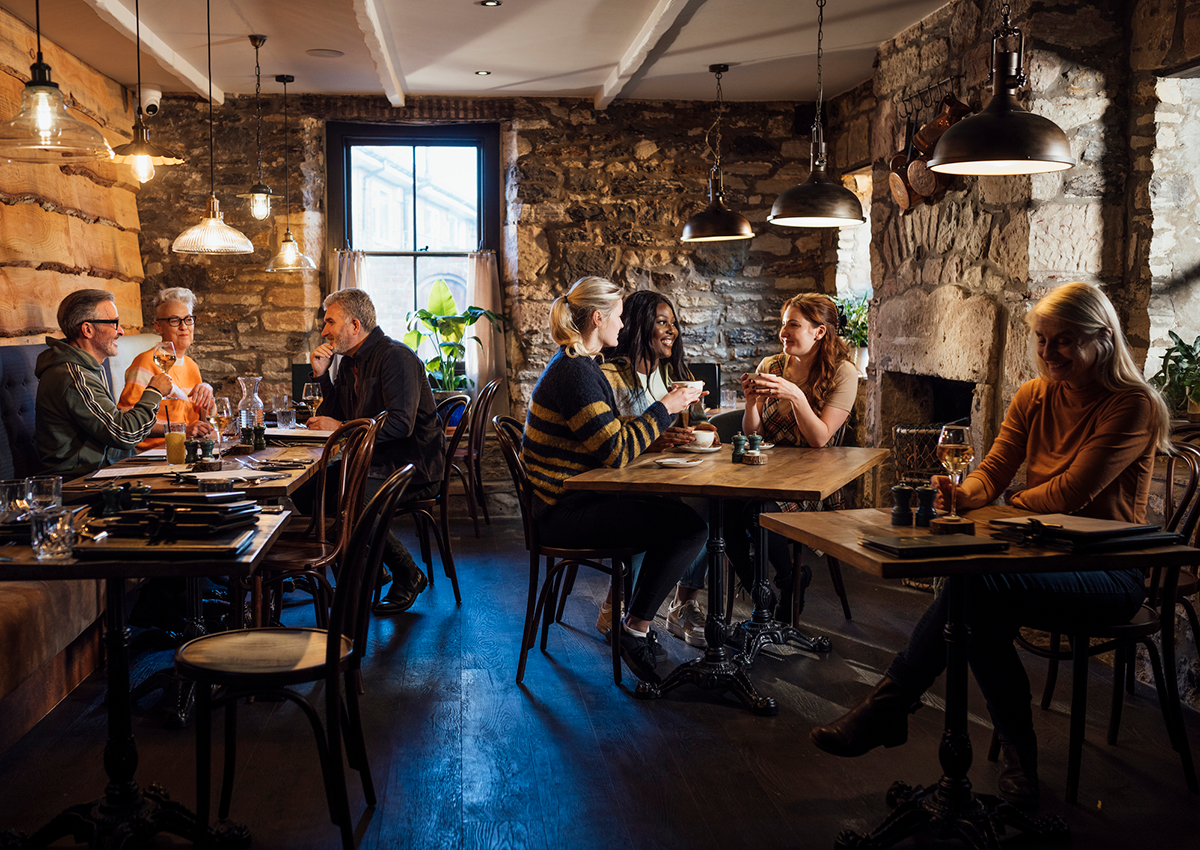Bar owners know the importance of table turnover time, especially during peak hours. The ability to make sales and keep people moving to allow for more customers is essential to a profitable business. However, some owners don’t realize they can leverage their bar POS data to make smarter table management decisions.
Managing a bar comes with unique challenges. One of these is that patrons may spend hours slowly sipping cocktails and enjoying the ambiance. That’s great until those guests are interfering with more paying customers who’d spend money if they just had a place to sit.
Join us as we discuss how your bar POS system can give you insight into slow table turnover as well as strategies to speed up bar service.
We’ll cover:
What your POS data reveals about table turnover
If you aren’t already using POS data to improve bar table turnover, you’re missing out on an integral piece of the puzzle that can simplify your strategy. Here are a few things you can learn from your POS system’s analytics.
Identify bottlenecks
Slinging drinks in a high-volume establishment is inherently fast-paced. There’s a lot going on at any given moment. Customers expect quick service and immediate attention, and bartenders often have to manage multiple demands at once, including taking orders, making drinks, and cashing out customers.
It can be hard to pinpoint where the holdup is when your staff doesn’t have a second to catch their breath. Fortunately, a great bar POS system can offer valuable data to show where your service slows down.
By analyzing daily data, you can identify whether your ordering process is taking too long, bartenders aren’t getting drinks out quickly, or slow payments are to blame. After all, you can’t fix a problem if you can’t find the root of it.
Peak hours and average dwell time
POS data for bars can also give you an idea of when you get the most customers and when those guests tend to camp out and take up space without ordering much. Analyzing daily, weekly, and seasonal trends can help you identify these peak times and come up with strategies to meet your customers’ needs and get them out the door so other guests can open a tab.
Use this equation to calculate your bar’s table turnover:
Table turnover = # of parties served ÷ # of tables in your bar
So, if you serve 45 parties in one night and your bar has 15 tables, your turnover rate is 3. You can also substitute seats for tables to get your average seat turnover rate.
Table-specific insights
You can narrow your focus even further by looking at specific tables where customers spend the most time. Your POS data should be able to provide insight into where and when your guests dwell the longest. For example, CAKE POS combined with reservation data can even help you see on average how long it takes guests to check out.
Maybe tables with a great view tend to keep people around longer than those by the restrooms. Perhaps certain servers always work the same section, or those with slower service always show up on your bar table turnover heat map. The information from your POS system should help you understand which tables attract lingering customers so you can determine the cause.
Strategies to increase table turnover (without sacrificing atmosphere)
Once you have detailed information and hard numbers that identify speed bumps in your operation, you can take steps to remove them and get things running smoothly–and quickly!
Here are some of our best bar efficiency tips to streamline your service.
Optimize table layout
Bars with cramped, hard-to-navigate floorplans will naturally have slower service than an efficient operation. Optimizing bar layout to improve turnover might be easier than you think.
Do a walkthrough of your bar during peak hours and see which spots have roadblocks that keep servers and customers from getting through. Creating a space that’s easier to navigate may require removing tables or seats, but it could pay off if it allows your staff and guests to get where they need to be.
It might be worth ditching fixed barstools in favor of mobile options you can reconfigure during peak hours. You could also consider a standing-room-only section with an express menu of quick-service drinks like beer and wine to keep things flowing.
Streamline ordering & payment
In many cases, the easiest delays to improve are those caused by outdated ordering and payment systems. If your bar isn’t using a cloud-based POS system that offers perks like tableside ordering and QR-code payments, you’re bound to waste time making up the difference.
Using tablets to place orders at the table can allow your servers and bartenders to drastically cut down on the time it takes to place orders and reduce costly and time-consuming mistakes that are more common when they have to write down orders by hand and wait in line to input them into a terminal. If your data shows this is where your hangups are, it might be time to invest in an updated system.
Some restaurants, like Pacific Sushi, have found that tableside ordering increased revenue by 25%!
Menu engineering for efficiency
In order to increase table turnover in your bar, it’s important to curate your menu so that items don’t drain your bartenders’ time. If your menu is full of complex drinks that require a tableside performance, paring down the options could be in your best interest.
This goes for a complicated food menu, too. The more items your kitchen needs to prepare, the longer the turnaround time will be.
Your bar’s POS system should make it easy to see which items take the most time. In real-time bar or kitchen display systems can help staff view order times, modifications and queued tickets in one place. Once you have this information, you can adjust your offerings to streamline your output, which will make your bartenders’ jobs much easier.
Proactive bussing & table reset
Servers, bartenders, and auxiliary staff often manage multiple tasks simultaneously, so eliminating guesswork will help improve overall efficiency. You’ll need to ensure hosts, bussers, and other employees are on the same page in order to run a tight ship.
Discreet table timers that are integrated with your bar POS system can alert your staff to lingering customers. Plus, built-in table management software allows front-of-house employees to see real-time table status, so there’s no question about whether or not their next party is seated.
Tactics for specific scenarios
Every bar faces unique challenges that interrupt operations and make it harder to meet customers’ needs. Here are a few particular situations to plan for in advance.
Managing large groups
Large parties can throw off your bar’s flow and create a backlog for bartenders and kitchen staff, but there are many ways to address this situation.
If your space allows, set aside a specific part of your bar for large parties. This might be a separate room that offers a bit of privacy and keeps big groups contained. You can also limit supersized crowds to pre-set menus to reduce the pressure on your staff.
Aside from these logistical concerns, your bar POS system can make or break your server’s success with large groups. When servers and bartenders must navigate a complex interface or jump through hoops to split checks, you can expect your table turnover to reflect that outdated technology.
On the flip side, a state-of-the-art cloud-based POS system can give your employees the tools they need to get even the biggest parties in and out in a timely manner.
The “one drink and done” customer
Some customers just want to sip a frosty beer, kick up their feet, and enjoy the ambiance. And while bars cater to all types, the one-and-done patron can keep your big spenders from snagging a coveted seat at the bar.
This is another time that convertible bar seating can come in handy. Perhaps you add a few extra barstools during peak hours to not only increase the number of available seats but also encourage patrons to move along after they’ve had their fill.
You can also motivate your staff to upsell to these customers by offering high-end alternatives to their mass-produced lager of choice.
Of course, your reservation software should create customer profiles of all your regulars. Just like you’d make a note of a certain patron’s habit of leaving hefty tips, make sure your staff pings customers who tend to linger. This will help your whole team know what to expect and where to seat them the next time they come in.
Waitlist management
Managing bar waitlists is easier than ever with a great POS system. Your software should automatically alert guests when their table is ready and inform them of their status while waiting.
Take the case of Ippudo, a high-volume sushi restaurant in NYC that once struggled with an excessive number of walk-aways due to an unmanageable waitlist system. When they implemented a POS-integrated program, they decreased wait times by 50% and reduced walk-outs by 25%. Additionally, 94% of guests surveyed agreed that the integrated system was a major improvement.
The importance of staff training & communication
While a premium bar POS system can revolutionize your establishment and streamline your service, ensuring your staff is properly trained and in constant communication is another pivotal element for success.
Setting expectations
You can hire the best bartenders in town, but if the rest of your staff isn’t on the same page, service will suffer. Table turnover is a team effort, and it’s critical for both front-of-house and kitchen staff to work toward the goal of increased efficiency. Fostering a table-turnover mindset can keep everyone moving in the right direction.
You can hold regular staff meetings to highlight your employees’ strengths and remind them of areas where they can improve. When you have solid data from your bar POS system, you can quantify shortcomings and pinpoint areas that need work. As the boss, you’re no longer the bad guy–instead, you’re just conveying the numbers.
Using data for empowerment
Building upon those expectations, the data from your bar POS system can truly empower your employees. Your software’s analytics can help bartenders, servers, and other staff understand the “why” behind certain strategies.
Uninformed employees might think particular protocols are unnecessary unless they can see the big picture. Arbitrary rules can make employees feel like they’re being micro-managed. Fill in the blanks using solid data and sound reasoning to show your staff how certain systems benefit them as well as their customers.
Emphasize customer experience
If you want to improve bar revenue, it’s essential to ensure your customers have a great experience and feel like VIP guests. Patrons who feel rushed out the door likely won’t want to return anytime soon. After all, increasing bar turnover isn’t about hustling your customers. It’s about streamlining your operations to serve more people.
Train your staff to gently and indirectly encourage guests to move along. Bartenders might offer “one last drink” as a way to prompt their customers to wrap it up.
Other innovative ways to get people moving include partnering with nearby businesses to promote “next stop” promos. Consider collaborating with a coffee shop or cafe where your guests can get dessert once they’ve finished their drinks. This will promote a seamless handoff and build community at the same time.
Conclusion
Your bar POS software has the power to transform your business from functional to fantastic. By leveraging in-depth data, you can identify hangups in your operation and optimize your menu, floorplan, and operating procedures to increase table turnover.
After all, fast, efficient service leads to happier customers and increased bar revenue.
CAKE’s POS solutions were made with bars and restaurants in mind. We understand what it takes to run a successful establishment and will be with you every step of the way as you navigate your new system. Contact us today to find out how we can help you reach your goals!







